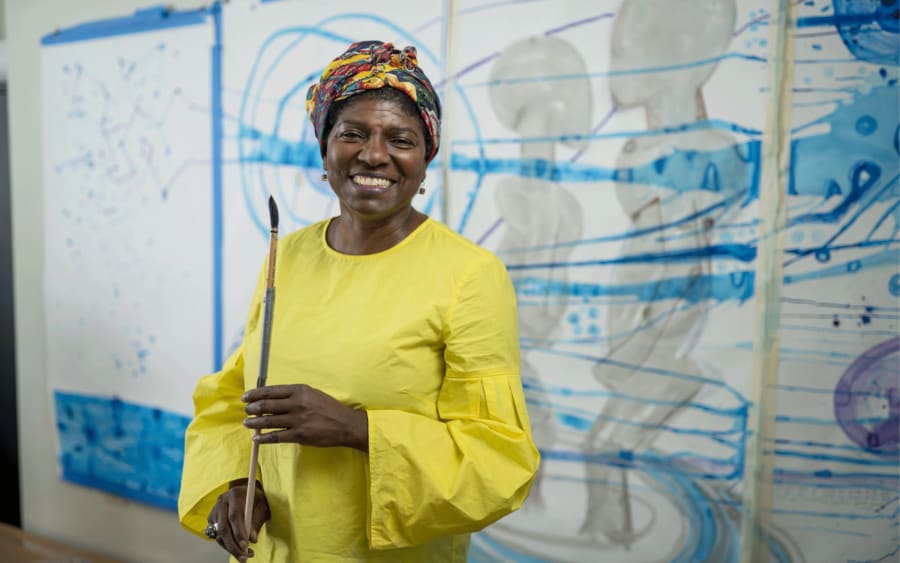For San Francisco gallerist Wendi Norris, words matter. More so than ‘surrealist’ – the characteristic most often attributed to her program – ‘textual’, ‘poetic’, and ‘narrative-driven’, best describe her artistic project and curatorial vision. Of the artists she represents, which include María Magdalena Campos-Pons, Chitra Ganesh, Enrique Martínez Celaya, and the estates of Leonora Carrington and Dorothea Tanning, Norris says: ‘Whether they’re using text as a visual material, referencing a work of literature, incorporating their own writing practice, or just offering a strong sense of story, there’s always something linguistic.’
For this reason, Norris understands what’s at stake when artists’ lives and artistic practices are reduced to single words like ‘feminist’ or ‘surrealist’, often to the exclusion of all else. The latter presents a particular point of contention for Norris, who’s frequently credited with helping to rewrite the history of the Surrealism movement thanks to her involvement with luminaries like Carrington, Tanning, Remedios Varo, and Alice Rahon.
‘They were shaping their own entirely new flavor of Modern art with their own distinct vocabularies and modes of interdisciplinary making,’ Norris said. ‘You miss out on so much of what they were doing when you look through only one lens.’
Since leaving her career in tech to open her eponymous gallery in 2002, Norris has been doing what she calls ‘practice’ or ‘the work.’ This includes setting auction records, confirming museum exhibitions, securing institutional acquisitions, expanding scholarship, and cultivating industry-wide recognition for Carrington, Tanning, Varo, and Rahon. In more ways than one, the gallery has acted as a catalyst for the large-scale revaluation of pioneering 20th-century women artists that we see today.
Case in point: the gallery’s 2019 presentation ‘The Story of the Last Egg’, featuring cosmic paintings and sculptural masks spanning four decades of Carrington’s career. The pop-up exhibition on Madison Avenue in New York City garnered more than 6,000 visitors in four weeks; The New York Times art critic, Roberta Smith, ranked it amongst the best of the year, and The Museum of Modern Art acquired one of the paintings on view. Cecilia Alemani first encountered Carrington’s writings at the exhibition, including the text that inspired the title for her 2022 Venice Biennale: ‘The Milk of Dreams’.
Norris met Carrington in 2004; two decades later, her voice still trembles as she expounds on the transformational nature of her first visit with the artist at Carrington’s home in Mexico City and the ensuing relationship that lasted until the artist’s death in 2011 – and beyond. Not only does Norris still represent Carrington’s estate, but their personal connection has also endured, albeit in a somewhat altered form. ‘She’s still guiding me or haunting me, depending on the day – she can be ornery,’ Norris said, giggling as she wiped her eyes. ‘She’s my guardian angel, and her magic is absolutely real.’
For those familiar with Carrington’s pictures and prose, claims of otherworldly encounters may not come as a surprise, especially considering the fact that the self-exiled artist understood her work as a ‘rebellion against the limitations of the physical world.’
The success of the 2019 Carrington exhibition also ratified the off-site gallery model Norris had adopted two years prior. As much as she loves words, Norris may love numbers even more. When in 2017, the self-identified ‘data junkie’ ran the figures and found that less than 10% of gallery sales originated in their 6,000-foot downtown San Francisco space, she reimagined her approach to the traditional brick-and-mortar configuration. Moving her ‘global headquarters’ to a smaller location, Norris embraced a more nomadic strategy, decentralizing her programming and staging exhibitions in vacant commercial spaces around the world. ‘It’s really artist-driven,’ she said. ‘We go where their market and audience are, and where we know their work will be well-received and also celebrated.’
This impassioned commitment to realizing her artists’ visions seems to permeate every aspect of both Norris’s business model and her overall thinking. When this observation is pointed out, Norris casually dismisses it as ‘just part of the work’ before launching into another animated description of an artist’s upcoming project – like the centerpiece of the gallery’s first-ever Art Basel Miami presentation planned for this December: María Magdalena Campos-Pons’s lyrical, large-scale blown glass sculpture, Alchemy of the Soul (2015).
The intergenerational two-person booth will feature Campos-Pons’s alchemical sculpture alongside fabulist gouaches by the artist who inspired her to create it: Remedios Varo. ‘The first time I met Magda, eight or nine years ago, she told me she was Remedios Varo reincarnated,’ Norris said. ‘And she was only willing to meet with a gallerist because I represented Remedios…now here we are, showing them together for the first time ever.’ Besides a shared literary sensibility, Norris acknowledges that many of her artists also engage with a spiritual dimension, whether mythical, philosophical, or ecological.
No matter what you call it, what Norris is creating in San Francisco – and beyond – is, without a doubt, nothing short of magic.
Tara Anne Dalbow is a writer, curator, and critic living in Los Angeles. Her work has been featured in W Magazine, Bomb, Frieze, Artnews, Flaunt, Art Papers, and more.
Gallery Wendi Norris will participate in the Galleries sector of Art Basel Miami Beach 2024, from December 6 to 8, 2024. Learn more here.
Caption for header image: Installation view of ‘Remedios Varo: Encuentros’, Gallery Wendi Norris, San Francisco, 2023. Photograph by Glen Cheriton.
Published on November 14, 2024.


